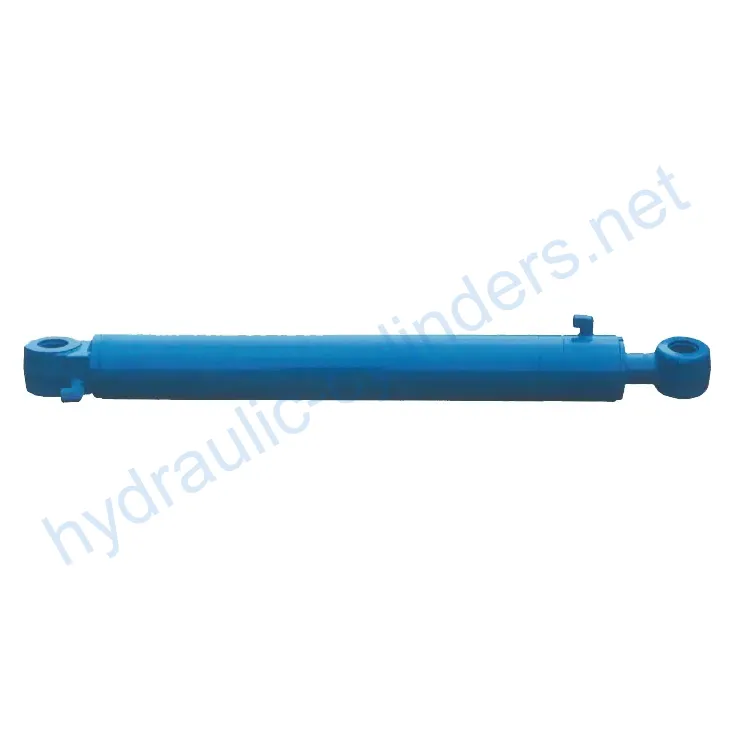Arm Cylinder For Yuchai YC60-8
Als één van de fabrikanten, de leveranciers en de exporteurs van van de hydraulische cilinders mechanische producten, bieden wij hydraulische cilinders en veel andere producten aan.
Neem contact met ons op voor meer informatie.
Mail:sales@hydraulic-cylinders.net
Fabrikant leverancier exporteur van hydraulische cilinders.
Arm Cylinder For Yuchai YC60-8
Introduction
The arm cylinder is a specially designed hydraulic cylinder that provides linear motion and power to the arms of various machinery, such as excavators, cranes, and robotic arms. It plays a crucial role in hydraulic systems, enabling the effective movement and control of additional tools or attachments. These cylinders not only provide smooth motion but also withstand heavy loads, ensuring efficient operation and reliability of the machinery under various working conditions.

Features
- High-efficiency transmission: The arm cylinder provides powerful linear motion and force, ensuring high-performance capabilities for the robotic arm in various operations.
- Precise control: Through the hydraulic system, the arm cylinder enables precise motion control, making the operation of additional tools more flexible and accurate.
- Durability: Arm cylinders are typically made from high-strength materials, offering good wear resistance and corrosion resistance, making them suitable for long-term use in harsh environments.
- Multi-functional adaptability: These cylinders can be widely applied to various machinery, such as excavators, cranes, and robotic arms, adapting to different job requirements.
- Easy maintenance: The design considers ease of maintenance and replacement, making regular inspections and maintenance more convenient and reducing equipment downtime.

Applications
The arm cylinder finds its applications in various industries:
- Construction Engineering: In excavators and cranes, the arm cylinder controls the movement of the bucket or boom, facilitating earthmoving, material handling, and structural installation.
- Manufacturing Industry: In automated production lines, the arm cylinder is used for the motion of robotic arms, enabling assembly, welding, and material handling processes to enhance production efficiency and precision.
- Agricultural Machinery: In agricultural machinery such as harvesters and planters, the arm cylinder controls the movement of the operating arm, executing tasks such as seeding, fertilizing, and harvesting.
- Mining: In mining equipment, the arm cylinder controls the arm movement of mining machinery, facilitating the extraction and transportation of minerals.
- Logistics and Transportation: In forklifts and handling robots, the arm cylinder controls the lifting and movement of forks, enabling material handling and stacking.
Design Considerations and Selection Criteria
When designing the arm cylinder, several factors need to be considered:
- Bearing capacity: The arm cylinder should be designed to withstand the expected loads and forces in the specific application.
- Sealing: Various sealing components, such as piston seals and rod seals, should be carefully selected, using materials like polyurethane and nitrile rubber, to ensure wear resistance.
- Durability: The cylinder body and threaded ends should undergo meticulous processing to enhance wear resistance.
- Safety: Safety features should be incorporated into the design, ensuring the reliable operation of the arm cylinder.
- Maintainability: Regular maintenance and easy replacement of components should be considered in the design to minimize downtime.

Sealing and Lubrication
The arm cylinder employs various sealing elements, such as piston seals and rod seals, made from wear-resistant materials like polyurethane and nitrile rubber. The cylinder body and threaded ends undergo precise processing to enhance wear resistance. Regular lubrication with the appropriate amount of hydraulic oil is necessary to ensure smooth operation.
Regular Inspection and Preventive Maintenance
To maintain optimal performance and extend the lifespan of the arm cylinder, regular inspections and preventive maintenance are essential:
- Check for oil leaks or damage to seals and replace if necessary.
- Inspect the cylinder body and rod for signs of wear or corrosion.
- Ensure proper lubrication and replenish hydraulic oil as needed.
- Verify the cleanliness of hydraulic fluid and replace if contaminated.
- Check connections, bolts, and fittings for tightness and make adjustments if required.
Product Installation Guide
Proper installation of the arm cylinder is crucial for optimal performance and safety. Follow these steps:
- Prepare the work area and ensure safety measures are in place.
- Inspect the cylinder and associated components for damage.
- Position the cylinder and align it with the mounting points.
- Securely attach the cylinder using appropriate bolts and fittings.
- Check the alignment and adjust if necessary.
- Ensure all connections are tight and leak-free.
- Perform a thorough function test to verify proper operation.

Safety Considerations and Environmental Factors
When using arm cylinders, it is crucial to prioritize safety measures to prevent accidents and ensure a safe working environment. Implementing proper safety protocols and providing appropriate training for operators are essential for preventing injuries and equipment damage.
Troubleshooting and Common Issues
Here are some common troubleshooting tips and solutions for potential issues that may arise with arm cylinders:
- Issue 1: Slow or jerky movement
- Solution: Check for insufficient hydraulic fluid, leaks, or damaged seals. Refill or replace as necessary.
- Issue 2: Excessive noise or vibration
- Solution: Inspect for loose connections, damaged components, or misalignment. Tighten, repair, or realign as needed.
- Issue 3: Cylinder fails to extend or retract
- Solution: Check for blockages, damaged seals, or insufficient hydraulic pressure. Clear blockages, replace seals, or adjust pressure accordingly.
By following these troubleshooting steps, readers can effectively diagnose and resolve issues with their arm cylinders. Additionally, implementing preventive measures can help minimize potential problems.

Remember to organize the article logically, use subheadings for easy navigation, incorporate relevant images or charts for enhanced understanding, and ensure the content is clear, concise, and suitable for readers with different levels of technical knowledge.
Author: lyl


Take a Tour of Our VR Factory:
Take a tour of our VR factory with the following
How Does Forklift Hydraulic Cylinder Work?
Hydraulic Cylinder Application:


